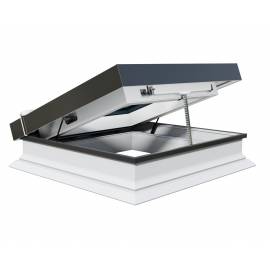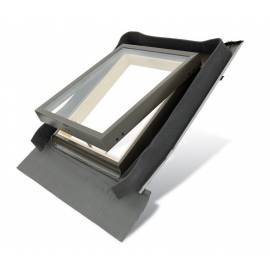Roof windows are among the most popular methods of bringing more natural light into your home and for good reason. They are relatively easy to install, come in a range of sizes, styles, and materials to suit any home’s aesthetic, and most importantly, they can dramatically transform the amount of natural light in your home.
There are two main types of roof windows: flat roof windows and pitched roof windows. At first, it may seem like the choice is simple. You either have a flat roof or a pitched roof, so you should just get the appropriate type of window, right?
In short, yes. But there’s a bit more to it than that. In this article, we explore the key differences between flat and pitched rooflights windows, covering the pros and cons of each – including maintenance, energy efficiency, and durability. By the end, you should have a good idea of which roof window is the perfect solution for your home.
Table of Contents
What is a Rooflight?
Before we get into the differences between flat and pitched rooflights, let’s briefly cover what a rooflight is and how it works.
A rooflight – also known as a skylight or roof window – is a window that is installed in the ceiling, allowing more light to enter your home from above. They are a popular choice for loft conversions and other rooms with limited access to natural light, as well as for those in which you want to create a brighter, more open-feeling space.
They first appeared in the early 19th century and were commonly used in commercial buildings, such as factories. In recent years, however, they have become increasingly popular in residential properties too – they are a great alternative to those bulky dormer windows.
What Is the Difference Between a Flat and Pitched Rooflight?
The main difference between flat and pitched roof windows is in the angle of the window. As their name suggests, flat roof windows are installed horizontally on a level surface. Conversely, pitched roof windows are installed at an angle, typically between 15 and 60 degrees.
This stems from the way in which both types handle water and debris. With pitched rooflights, this isn’t much different from a regular window, as the slanted glass helps rainwater and debris to simply slide off. To prevent water and debris from entering, flat rooflights need to be installed with a special waterproofing membrane and an internal drainage system.
This isn’t to say that flat rooflights have to be fixed. In fact, many are now available with an electric opening mechanism that allows them to open all the way to 90 degrees, making them just as functional and versatile as any other windows. Following this, not all pitched skylights are openable either.
Do I Need Planning Permission to Install a Rooflight?
Installing rooflights falls under the Permitted Development (PD) scheme. This means that you are allowed to install rooflights without planning permission provided they meet certain criteria. This is important because not all types of skylights can be installed without a roof extension.
Most flat skylights require at least a minimal extension to the roof, and any addition to your roof plane that exceeds 150mm in height will require you to obtain planning permission.
What is a Rooflight Loft Conversion?
Since the introduction of Velux pitched roof skylights, you didn’t have to employ scaffoldings in order to install a pitched roof window – the idea was to have them installed by a carpenter in one day.
This led to the development of the so-called “rooflight loft conversion”, where a set of skylights is placed on the pitched roof and the attic space is converted into a living area. Needless to say, the build cost is a fraction of the one for a traditional dormer conversion, leaving more money to spend on quality materials and fixtures.
Do Skylights Let More Natural Light In?
Skylights, compared to conventional windows and dormer skylights, let more natural daylight into the room below. This is due to the fact that they are often set on a higher level and are facing the sky.
This allows for a more even light transmission lasting for a longer time, which is perfect for reading and working. Additionally, the light coming from above creates the illusion of more space, making the room feel bigger and brighter.
Types of Roof Windows
As mentioned above, rooflights can be divided according to their angle. Within those two categories, however, there are a few different types of windows to choose from. Let’s briefly explore the main types of flat and pitched skylights.
Pitched Roof Skylights
Pitched roof windows can be further divided according to the hinge – centre pivot, top-hung, and escape exit.
The most popular type is the centre pivot window, which opens from the middle and can be rotated up to 180 degrees. This allows for plenty of ventilation and easy cleaning, and it doesn’t require any special hardware or support.
The top-hung window, on the other hand, opens from the bottom and depending on the profile can be tilted up to 30 degrees. It is a good choice for rooms with low ceilings, as it doesn’t protrude into the room when opened.
The escape exit window is a special kind of top-hung skylights that is designed to open to 45 degrees and more, making it ideal for higher-pitched roofs. It is often used in loft conversions, where it can provide a wide view and plenty of ventilation.
Other products in category: Sunlux centre pivot
£157.50 tax excl.
Flat Roof Skylights
When it comes to flat roofs, there are more options to choose from. The most popular type is the fixed skylight, which can’t be opened but provides plenty of daylight. They typically come in flat rectangular skylights or pyramid shape lantern rooflights that are made of either glass or acrylic.
The next type is the electric opening window, which can be opened manually or with the help of a remote control. Some models are equipped with extra handrails motors, allowing them to be opened up to 90 degrees and used as roof access.
It should be noted that not every flat skylight can be walked on. This is why some brands provide reinforced walk-on models that are designed to support the weight of a person. These models come with an extra layer of laminated security glass along with double or triple glazing, which makes them more durable and safer to use.
Other products in category: Flat Roof Windows
£779.17 tax excl.
Maintaining Skylights: Useful Tips
Just as your conventional windows, skylights need to be regularly cleaned and maintained in order to function properly. Here are a few useful tips that will help you keep your skylights clean and in good condition.
- Your rooflights should be cleaned at least twice a year, preferably in spring and autumn to avoid extreme temperatures.
- Use a soft brush or cloth to avoid scratching the glass. For stubborn dirt, you can use warm soapy water.
- Never use harsh chemicals or abrasive materials, as they can damage the glass and the frame.
- If your skylight is placed in a hard-to-reach spot, you can use a pole with a soft brush attachment to reach it.
- In winter, you should check your skylights for ice and snow build-up. Use a soft brush to remove the snow and avoid using de-icing chemicals, as they can damage the glass. Never use hot water, as it can crack the glass.
- Make sure the drainage holes are clear of debris to avoid water leaks that can damage your ceiling.
- Always use safety gear when cleaning or inspecting your skylights, such as a safety harness and goggles. In the case of a fixed flat roof window, you may need to use scaffolding – or have them cleaned by a professional.
Pros and Cons of Skylights
There’s no denying that skylights have a lot of advantages. They are relatively easy to install, they come in a wide range of styles and materials to suit any home, and they can dramatically increase the amount of natural light in your home – and with that, improve energy efficiency.
Other products in category: RoofLITE+
£95.00 tax excl.
The U-value indicates how much heat passes through the window. The lower the U-value, the better insulated your window is and the less heat transfers through it. Most modern roof skylights come with either double glazing or triple glazing, which can dramatically reduce the U-value.
With that, your room should not get uncomfortably hot in summer, as the heat from the sun will be reflected back outside. If properly maintained, skylights should not lose any more heat than your conventional windows during winter.
Self-cleaning glass, which has become a popular feature, is a great choice for rainy climates as it will help keep your skylight clean with little effort on your part.
Lastly, rooflights add a wow factor to your home, making it more attractive to potential buyers. Ceiling skylights create a more open and airy feel, making the space feel bigger and brighter. Additionally, they can provide a stunning view of the night sky or act as an interesting focal point in your room.
But skylights also have a few disadvantages that you should be aware of before making a decision. They can be more expensive than regular windows – pitched roof rooflights start from around £ 100, while flat rooflights cost up to £ 1200, and they may require more maintenance due to their exposed position.
You may not be able to install skylights in any spot you want, as they must fit within the structure of your roof. Additionally, if not installed correctly, they can leak – which can cause damage not only to your skylight but also to your ceiling and the rest of your home.
It is safe to say, however, that the pros of skylights outweigh the cons. With proper installation and maintenance, they can last for decades – and bring plenty of light, style, and value to your home.


